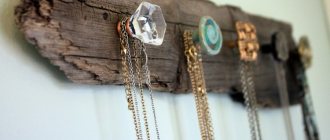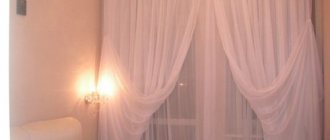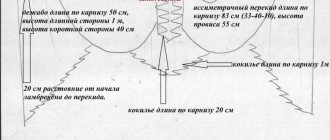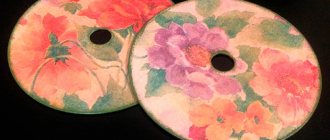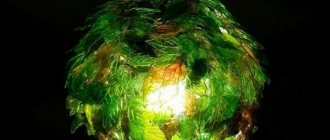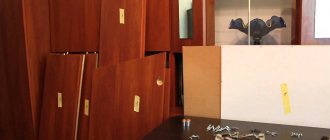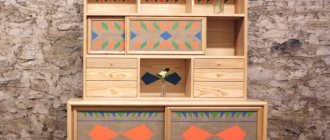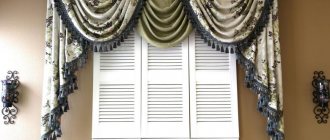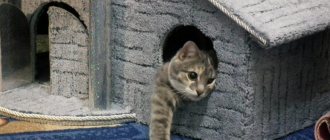Lamps play an important role in the interior of premises. The choice of lighting devices available for purchase in the retail chain is huge, but making a lamp with your own hands means enriching a room or apartment with a unique item.
Can you crochet? Publish your work on kru4ok.ru
DIY lamp: what you need and where to get it
Depending on the size of the home, its configuration, and the degree of illumination, additional light sources may be needed - chandeliers, sconces, floor lamps, table lamps. If you want to replace a government-issued lighting device with something refined, interesting and at the same time original, you should put in a little effort, use your imagination and make such a device with your own hands.
To do this you will need the following items:
- tripod (support or suspension, depending on the type of lamp);
- shade;
- electric cord with plug;
- LED lamp;
- socket for screwing in a light bulb;
- materials for a new floor lamp or pendant.
It is not difficult to make a lighting device, and the creative process itself will bring a lot of pleasure to the craftsman. It is also important that the cost of something made with your own hands is several times lower than store-bought goods of similar purpose.
- interesting selection on kru4ok.ru!!!
- We crochet round bags, a selection of patterns and descriptions
- … And
The socket, cord and lamp can be purchased in any department where electrical goods are sold, or in special stores.
store. Cords are presented in a huge assortment; it is important to decide before visiting the store how long the electrical cord with a plug is needed. The material of the cord can also be different; the consultant is obliged to help determine the choice. If you want to have a push-button switch on the cord, which is especially important for bedside sconces and floor lamps, you should buy a power cord with such a switch.
The lamp must be halogen or LED.
This is important not so much for the purpose of saving energy, but for ensuring fire safety. Incandescent lamps emit heat, which can cause the lampshade to catch fire if materials such as paper, fabric, etc. are used. To ensure that a home-made electrical appliance is safe, incandescent lamps are not recommended.
The lampshade is the main element that carries an aesthetic load. It is this detail that needs to be given special attention and maximum imagination to make the item exclusive. Any objects available in the house suitable for this purpose are used as a tripod (or base) - the base of an old lamp, an unnecessary vase or its lower part, as well as wood, metal, plastic, etc.
What materials are the lampshades made from?
The following materials are used to make the lampshade:
- paper, cardboard;
- textile;
- openwork material - guipure, tulle;
- plastic;
- metal cans;
- foil;
- artificial flowers;
- beads, etc.
The general appearance of the lamp and especially the lampshade must match the design style of the entire room. With your own hands you can make lighting devices of the most bizarre shapes - spherical, cylindrical, in the form of a truncated cone, prism, etc.
A good option might be a lamp made from a cascade of lighting elements. If the design of the room allows, you can use the pattern of the fabric to crochet or knit an openwork lace lampshade. It is original, beautiful and homely, especially in the bedroom. The main thing is that the basic concept of room design is supported.
For a do-it-yourself lampshade frame, you most often use an existing frame from an old lamp or wire or knitting needles, giving it the chosen shape. When creating a unique lighting fixture, the home craftsman has the right to play with the color scheme, always taking into account the nature and purpose of the lamp.
A creative approach to the idea of making a lamp with your own hands will allow you to get an exclusive model of a sconce, floor lamp, chandelier or table lamp. The small costs are more than compensated by the beauty and originality of the desired lighting fixture, which will also fit perfectly into the interior of the room.
Chandelier from a bottle
To make an original lighting fixture from a bottle, you need the following items:
- Lamp;
- Glass bottle;
- Glue;
- Bulgarian;
- Masking tape;
- Sandpaper;
- Cable.
First, all materials are selected according to size. The bottom is cut with a grinder. Before cutting the lower part, you need to wrap the intended area with masking tape so that the cut is smooth and without chips. Then sandpaper is moistened with water and the edges of the cut are processed.
The next step is to assemble the entire structure together. A cord is threaded through the bottom of the bottle until it stops at the neck, but the switch remains outside. It is better to lubricate the cartridge with glue in advance or come up with a rubber clamp so that the structure is motionless.
Afterwards, the light bulb is placed in the socket, and the cord is connected to electricity.
First launch and setup of Wi-Fi
I used the firmware from, to configure other firmware, read their description on the developer's page.
1. We supply power to the lamp, and on the smartphone we find the LedLamp access point that appears with the password 31415926 (the access point name and password are configured in the firmware)
We connect and wait for the authorization window to appear.
3. Select Configure WiFi and connect to your home network.
4. After rebooting the lamp, find it in the web interface or application of your router to find out the received IP address.
5. Install the Arduino Lamp application from the App Store (for other firmware you need to use other applications).
6. Enter the IP address of the lamp and connect.
Bottle night light with LEDs
Instructions on how to make a lamp with your own hands using an ordinary glass bottle. For this idea you will need:
- Bottle;
- Garland;
- Glue;
- Pencil;
- Sandpaper;
- Drill with drill;
- Double-sided tape;
- Water;
- Clay.
Once you have prepared the necessary items, you can begin making the night light. Take a washed bottle and mark the hole where the garland will go. A clay ring is placed on the mark to prevent chips and cracks.
When drilling, it is necessary to add water, as the drill and bottle will heat up. All uneven elements are cleaned with sandpaper moistened with water.
After receiving the hole, the garland is threaded, but only the lighting part. It is also necessary to take into account that the light bulbs get very hot, so a garland with LED lamps is used. The regulator remains outside and is installed on the bottle with double-sided tape for convenience.
For outdoor lighting
Homemade low-voltage cable entry into an outdoor lamp
We will leave 220 V outdoor lamps as purchased: it is impossible to make a “forever” sealed cable entry for mains voltage and also a sealed housing with glass at home. We will work with voltages up to 12 V, then the cable entry will be quite simple, see fig. And if the light source is powered from a current stabilizer, then no short circuit will be scary.
However, it may not come down to electricity: for temporary lighting in the garden or at a picnic, even in the 21st century, an ordinary candle is often more convenient and cheaper, and it is also more romantic. And you can make a candle lantern with your own hands from a coffee can in just a few minutes, see video:
Video: DIY candle lantern from a coffee can
This lamp is also suitable for a light bulb; then there is no need for ventilation holes and the carrying handle can be attached to the lid, which is more reliable.
A permanent outdoor lamp must already be electric. The main problem in this case is reliable sealing. Here again, glassware with a screw-on lid comes to the rescue: a jar makes a good outdoor lighting fixture. In this case, because a more powerful light source is required, it is better to take a container from conservation. The cable entry pipe is made by piercing the cover with a round pointed rod. To ensure a complete seal, aquarium silicone is applied to the inside of the lid rim once and for all before screwing it on.
A “once and for all” lamp involves the use of very reliable and durable light sources. Requirements for its quality and spectrum fade into the background, because It is not the living or working space that is illuminated. Taking these conditions into account, it is better to make an outdoor lamp on the porch or, say, at the entrance to the garage from an LED strip: it will provide sufficiently bright lighting with a negligible electricity consumption. For an example of making such a lamp, see:
Video: DIY garden lantern in 15 minutes
In the garden and in general on the site, high brightness of lighting is no longer needed, here, in general, just so as not to leave the path and see the door to the bathhouse, cellar, barn or bathroom. But it is very, very desirable to have a garden lamp that is autonomous: the issue here is not the cost of electricity, but of the cable, and who would like to ruin a well-groomed area with trenches?
Garden lamps powered by solar panels (SB) and a backup battery (Battery) are on sale, but they are either expensive or short-lived. Let’s try to figure out whether it’s possible to do this on our own, especially since it’s quite possible to make a solar battery with your own hands:
- 4 white LEDs with a current of 20 mA each in a lampshade made of milk glass or a frosted plastic bottle will illuminate a circle with a diameter of 4-5 m more or less acceptable for garden needs. With a current of each 10 mA in the light spot it will still be possible to see where the stone is, and where is the hole? Total average 60 mA.
- The battery, taking into account weak recharging in winter and reduced capacity in the cold, should provide maximum current to the lights for at least 30 hours. Pen-type batteries with a capacity of 2500-3500 mAh, frost-resistant down to –20, are available for sale. We take the minimum permissible battery capacity of 2500 mAh.
- Voltage drop across the luminous diode is approx. 2 V. In order to stabilize the total current consumption and the battery discharge mode, on which its resource significantly depends, we give twice as much to the quenching resistors, so the total battery voltage is 6 V.
- The SB, taking into account the energy efficiency of the Ni-Cd battery at 74%, should produce a current of approx. 75 mA. For winter in mid-latitudes, we take a rated current of 100 mA.
- Also, taking into account the energy efficiency of the battery and voltage losses during charging, we take the battery voltage to 9 V.
- To ensure that the battery life does not decrease due to overcharging, the recharging current through it should not be more than 5% of the hourly discharge current. With a battery capacity of 2500 mAh and a short-circuit current of 100 mA, this condition is met, and even more so with a battery capacity of 3500 mAh. That is, instead of an expensive and complex charge controller, you can simply install a silicon rectifier diode.
The diagram of an autonomous garden lamp, built taking into account the described conditions, is shown in Fig.:
Scheme of an autonomous garden lamp with a solar battery
Despite its simplicity, the battery in it is never brought to the point of degradation of the active medium due to overcharging and only in exceptional cases can it achieve a deep discharge; therefore, its service life remains normal when operating in harsh temperature conditions. The “highlight” here is SB. Their internal resistance is large and nonlinear, according to a power law, and increases with increasing load current, as a result of which the short-circuit current of the SB is only slightly greater than the rated one. From this point of view, in this circuit it is more profitable to use less expensive polysilicon SBs.
The control device CU closes the switch S when the SB voltage drops to the “twilight” level. By that time, VD1 will have already closed and the battery will stop charging. The control unit is connected to the battery only for power supply. Switch - diode or transistor optocoupler or electromagnetic relay; in this case, a reed switch is better, because a conventional one with a low-voltage coil will draw more current than all LEDs. In this case, it is impossible to use a thyristor optocoupler as an S: in order for the opened thyristor to close, the current through it must drop to a very small value, almost to zero. Since the current here is constant, the thyristor, once opened, will not “stop” until it completely drains the battery.
Ball-shaped lamp
Master class on how to make a spherical lamp. To make such an unusual lighting device, you will need:
- Base;
- Balloon;
- Thick threads;
- Glue.
Note!
DIY furniture decor - 145 photos of exclusive and modern design ideas
DIY pot decor step by step: simple decorations and decor options for pots made from different materials
To begin with, prepare a place for work; all work is done on oilcloth so as not to stain the surface. You need to inflate several round balloons, mark a hole for a stand with a lamp and dilute the adhesive solution.
When the solution is infused, the threads are soaked and applied one at a time in a chaotic manner. Each thread will need to be tied to the tail of the balloon, and excess glue will need to be collected so as not to spoil the appearance.
Once a uniform ball of thread is achieved, the entire structure is suspended until completely dry. Afterwards, the ball will need to burst, and the tail of the ball will need to be cut off and everything removed through the hole. The lamp is ready, all that remains is to thread the light bulb and place it in the center.
Materials
It is worth paying attention to safety precautions and using non-flammable materials. You should not use paper, plastic and similar materials that have a fairly low combustion temperature.
As for the lamps themselves, it is worth using LED lamps, as they have many advantages, such as a long service life and do not overheat. It also has several shades and, of course, saves energy.
Lamp made of metal pipes
Schemes for DIY lamps in the loft style are very simple. To create such unusual lighting you need:
- Non-functioning water pipes;
- Incandescent lamps;
- Connecting elements;
- Cable for connecting lamps.
To begin with, a cable is passed through each sample and connecting element, thereby creating a single structure. Next, all the elements are screwed in, and a light bulb with a socket is inserted into each end. It is better to use brass pipes.
Shabby chic style
To make lighting in this style, you will need fabric and beads. Such lampshades look elegant and amaze all guests of the house with their sophistication.
Necessary materials:
- metal carcass;
- cartridge;
- beads and beads of different sizes;
- threads and chains for decoration.
In fact, such work does not require special skills. But you will need patience, because the process will take a lot of time. Usually, for lampshades, three rings of iron wire are taken, of the same or different sizes. If they are the same, then we get lighting in the Art Nouveau style.
It is important to consider that before you start decorating the product, you need to paint it and stretch the material around the frame.
Finished lampshade, trimmed with beads and beads, to your taste. If desired, you can decorate with rhinestones.
As you can see, there are quite a lot of options for hand-made chandeliers. At the same time, such an interior element will decorate any room and make its furnishings original and unique, which will show the original nature of the housewife. With this lighting of your home, you can decorate any room and your guests will certainly admire your talent and originality of taste.
Lighting device made from CDs
The idea of such a lamp is very simple, because it will require:
- CDs;
- Aluminum or copper wire;
- Hole puncher;
- A tube suitable for the diameter of the hole in the center of the disk;
- Bulb;
- Cable with cartridge.
To create such a unique lamp, you need to pierce each disc along the edges using a hole punch. Upon completion, connect each element with wire and get a round structure.
Leave one CD unattached. Pass a tube with a cable through the hole and place a light bulb inside, and only after that fasten the last disk.,
This lamp will go well in a room designed in the style of computer games or just on a computer desk.
Final assembly
The next step will be the actual assembly. To do this, the assembled filling is attached to the reflector using glue. The adhesive connection must be reliable, since these two elements will only be held on by glue. After everything has dried, you should mark each of the terminals, and also indicate the rated voltage of our lamp. Pieces of copper wire must be cut in accordance with the length of the electrodes of the halogen lamp.
Lighting fixture made from cupcake tins
A chandelier made from cupcake tins is no less attractive.
To create it you need:
- Paper cupcake tins;
- Frame base;
- Glue;
- Bulb.
A round base is made; wire works well. The first molds are glued to the rods with their bottoms; they are the foundation. Next, in a circle, they are glued with edges, always with the bottom inward. Upon completion, a small hole is left at the top to allow the cable with socket and light bulb to pass through.
Children's lamp: soft toy
The fabric should not be too dense and allow light to pass through. Therefore, you can use flax. When choosing a pattern, it is important to take into account the wishes of the child. Cut the fabric and connect all the parts except the bottom. Fill with sealant.
The fabric is impregnated with any composition that makes it dense (starch, gelatin).
The improvised lampshade should dry well. A small hole is made at the bottom for the cord to exit. The seal is removed. A prepared LED cord is laid inside the structure. You can use a New Year's garland. The bottom is sewn up: the lamp is ready.
Cloud lamp
This kind of lighting device will fit perfectly into a child’s room, and to create it you will need to prepare:
- A small wooden block;
- Cardboard;
- Dye;
- Wall Light;
- Sandpaper;
- Jigsaw.
A cloud-shaped structure is cut out of the block and processed with sandpaper, and the remaining complementary elements are created from cardboard. Then the finished cloud and other structures must be painted with the appropriate color and allowed to dry.
After drying, the wooden cloud is mounted opposite the wall lamp, and the remaining elements are not far from each other, complementing the picture.
Adviсe
To complete the work of making a lamp successfully, we have collected the most practical tips that will definitely come in handy:
The use of energy-saving lamps is recommended for the product. Why is it undesirable to use conventional ones? They increase the risk of overheating and fire, so if you want to use incandescent lamps, you will have to constantly monitor the condition of the lamp and also buy a fire extinguisher.
You can use old garlands left over from the New Year as decoration. The lighting they create will add coziness to the room.
To create new lighting items, you can modify old lampshades and lamps that everyone probably has lying around.
Lamps can be used to diffuse light and correct the interior, but we strongly recommend avoiding the opposite effect: hiding the light.
Chain-link chandelier
To make lighting from this mesh, you need:
- Rabitz";
- Frame base;
- Cable with cartridge;
- Bulb.
To create this type of chandelier, you just need to attach a mesh in a circle to the frame base and lower it to the desired size. At the end, secure with wire in color to make it look beautiful. You can also add decorative elements in the form of flowers.
Ideas
Looking at the photos of beautiful homemade lamps, you can’t help but be surprised at how developed the imagination of the designers is. To create lamps, different materials are used, from plastic to glass and fabric.
We invite you to consider the most creative ideas and figure out how to bring them to life by reading the instructions for decorating and designing lamps.
Clothespin lamp
It’s a great idea to use clothespins not only for their intended purpose, but also to create an unusual lamp. To do this you need to prepare:
- Wooden clothespins;
- Glue;
- Plastic tube;
- LED strip.
To begin, the clothespins are freed from the springs and taken apart. Next, each individual element is glued, creating a square. Then, each structure is glued together, and, if desired, each of them is rotated 90 degrees.
While the product is drying, a diode strip is wound around a plastic tube and inserted inside the structure after it has dried.
Devices with coupling capacitor
The most common and practical power supply circuit for LEDs is precisely. It takes up little space and does not require many professional skills to manufacture.
The figure previously depicted the classic diagram of a traditional feeder. It has a decoupling capacitor, a discharge resistor, a rectifier and a zener diode. It is not recommended to connect the circuit without a load, because the amplitude voltage value will be high and if one of the LED circuits breaks, the zener diode will fail.
Night light made from tin lids
If someone has a large number of tin cans, then you should not throw them away, because the lids from these cans can be used to make an excellent lighting device. To build such an unusual lamp you will need:
- Tin can lids;
- Old night light;
- Wire frame base;
- Wire cutters;
- Bulb.
First, the lids are removed from the jars. A wire frame base in the form of a circle is attached to the old night light at the top and bottom. Then the first caps go around the upper base of the wire, with the ends facing down.
Next, a cut is made at each cap to hook it to the previous one. When the structure reaches the bottom, the same procedure is done as at the top, the lid bends around the wire, thereby ending the chain.
Now we can say with confidence that from almost every available material you can make a lamp that will please the eye, or will simply suit the design.
This article contains only a small part of what lighting fixtures can be made from, but there are many groups on the Internet where there are not only photos of homemade lamps, but also a detailed description of each of them.
How to make a frame for a lampshade
Typically, a lampshade consists of two metal rings connected by jumpers (from 3 pieces). The shape of the frame can be trapezoidal, cylindrical or curly.
For the frame, wire made of any metal is suitable: copper, aluminum, steel. Using wire cutters, you need to cut two pieces of wire and make two circles out of them - one larger, the other smaller.
It should be noted that the design for the lampshade of a pendant chandelier is slightly different from the design of the lampshade of a table lamp, but in any case there is always another inner ring through which either the socket or the cord from the chandelier is threaded.
To work with wire, you will need wire cutters and round nose pliers (in order to make a neat loop to hold the wire together.
But, nevertheless, the most correct thing would be to buy a ready-made frame for the lampshade - fortunately, construction hypermarkets are full of them.
You can make a pattern for a lampshade like this:
So, the frame for the future lamp is ready and the most important thing to choose is the decor of the lamp and the material with which to work. We offer several options for making a lampshade with your own hands.
Lampshade made from scraps of fabric
To make such a lampshade you will need the following materials and tools:
- two pieces of fabric of different colors;
- lampshade frame (purchased or made yourself);
- threads with a needle;
- scissors.



